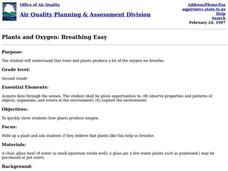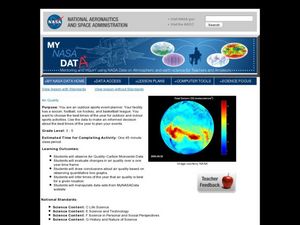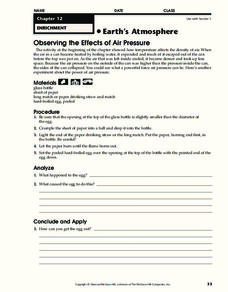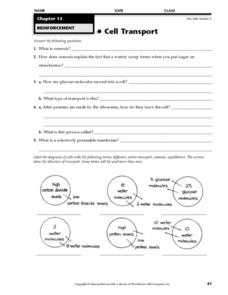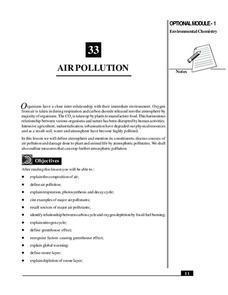Curated OER
Be Considerate of Others
Students explore the environment by participating in an outdoors activity. In this nature appreciation lesson, students discuss how to minimize their human imprint when experiencing nature. Students conduct a nature walk and plan out an...
Curated OER
Organic Matter in Soils
Young scholars recognize the presence of organic matter in soils from their immediate area and recognize which soil sample contains the highest concentration of organic matter.
Curated OER
Air Quality
Students investigate what is known as the Greenhouse Effect. They begin to explore what some scientist think is the nature and fundamental causes of this problem. Students are able to give suggestions for alternative causes of global...
Curated OER
How Does Your Plant Grow?
Students measure and record their height in centimeters on a graph. By integrating math and science, students collect data and apply graphing skills to the experiences they are having growing plants. Finally, students identify how to...
Curated OER
Significant Figures and Conversions
In this chemistry learning exercise, students identify how many significant figures are in each of the numbers listed. Then they determine the velocity in meters per hour for a subatomic particle. Students also determine how many...
Curated OER
Earth's Atmosphere
In this Earth's atmosphere learning exercise, students observe the effects of air pressure using an egg. They describe what happens to the egg and what makes it do what it does. Then they determine how to get the egg out of the bottle...
Curated OER
The History of Life
In this history of life instructional activity, students complete a crossword puzzle by figuring out the vocabulary words associated with the 11 clues given. Then students review how paleontologists use fossils to learn more about past...
Curated OER
The Biosphere
In this biosphere learning exercise, learners identify the different levels of organization that ecologists study. Students complete charts, sentences, and answer short answer questions.
Curated OER
Gases Around Us
In this gases activity, students look at 6 pictures, put a rings around the gases in each picture and then name each gas or gases on the lines provided.
Curated OER
Carboxylic Acid and its Derivatives
In this carboxylic acid learning exercise, students are given five problems to complete. Included are to name 10 given compounds, draw four compounds given their names, and complete 6 chemical reactions.
Curated OER
Build A Tree
Students study the different parts of a tree and the significance of each part. In this build a tree lesson, students use role-playing theater to reinforce what they are learning. Students use their imagination to become tree parts...
Curated OER
Hess's Law Cycle
In this chemistry worksheet, students write the balanced equation for the formation of one mole of fat from its elements under standard conditions. Then they write the balanced equation of the combustion of this fat. Students use Hess's...
Curated OER
Compound Exercise
In this chemistry worksheet, learners name each of the listed compounds on the sheet. Then they compare each of the compounds to those of the periodic table.
Curated OER
Cell Transport
In this biology worksheet, 9th graders describe what osmosis is and how it explains the fact tat a watery syrup forms when you put sugar on strawberries. Then they describe how proteins made by ribosomes leave the cell. Students also...
Curated OER
Half Life Analogy
Eighth graders explain half life. In this hands on activity, 8th graders use licorice to explain radioactive decay and graph their results.
NOAA
The Biogeochemical Cycle
The biogeochemical cycle ... no physics? The fourth installment of a 23-part NOAA Enrichment in Marine sciences and Oceanography (NEMO) program introduces the biogeochemical cycle by having pupils simulate movement between Earth's...
Biology Junction
Biochemistry of Cells
Chemistry and biology work hand in hand, without one you literally wouldn't have the other. Using a presentation, individuals learn about plant cells, animal cells, cell responses, macromolecules, DNA bases, and so much more. A worksheet...
It's About Time
Volcanos and the Atmosphere
In the summer of 1815, snow fell every month in New England. Was this related to the volcanic eruption of Tambora in Indonesia earlier in the year? Young scientists design their own experiments to research the long-term effect a volcanic...
America's Blood Centers
My Blood, Your Blood
Dracula isn't the only one who needs blood to survive. The eight-part unit includes seven lessons, five demonstrations, seven labs, and a project to organize a blood drive. Class members learn about the parts of...
Teach Engineering
Water Remediation Lab
Water filtration — that's pure genius! Groups test the ability of a water filter to purify water by running chlorine contaminated water through a filter and measuring the chlorine concentrations as they filter the water. They then graph...
Serendip
Photosynthesis and Cellular Respiration
How does energy from the sun make plants grow? Scholars move step by step through the processes that promote plant propagation during a detailed lesson. The resource illustrates ADP production and hydrolysis, then allows learners to...
National Institute of Open Schooling
Air Pollution
Seventy percent of the air pollution in China is due to car exhaust. Under the umbrella of environmental chemistry, learners extensively explore air pollution. From the makeup of our atmosphere to sources of major air pollutants, classes...
Deliberating in a Democracy
Global Climate Change
Students examine an environmental issue. In this global studies lesson plan, students read an article entitled, "Global Climate Change," and respond to the discussion questions that accompany it.


